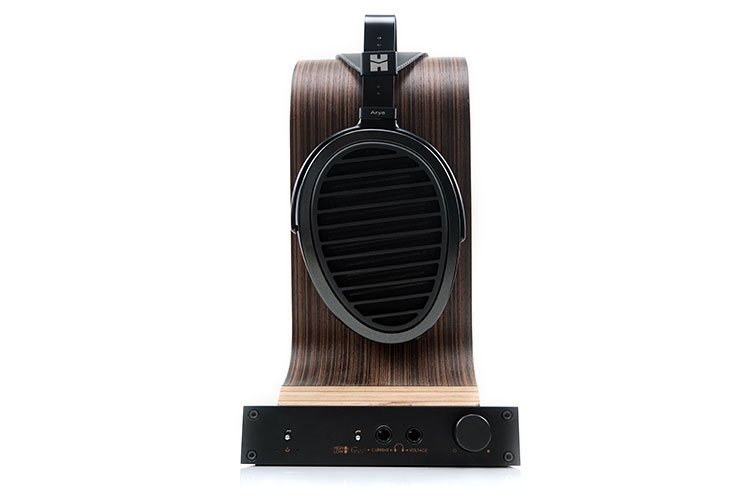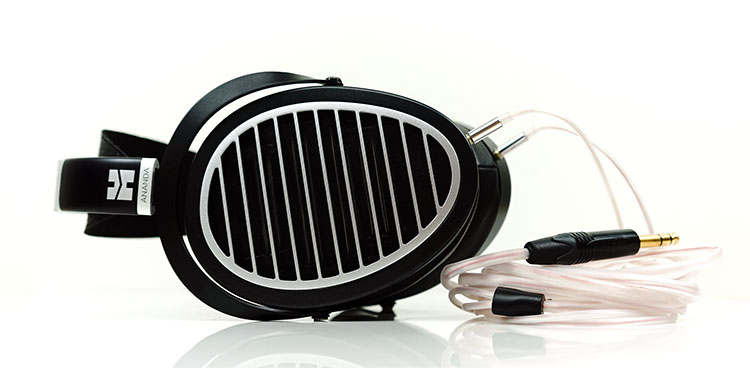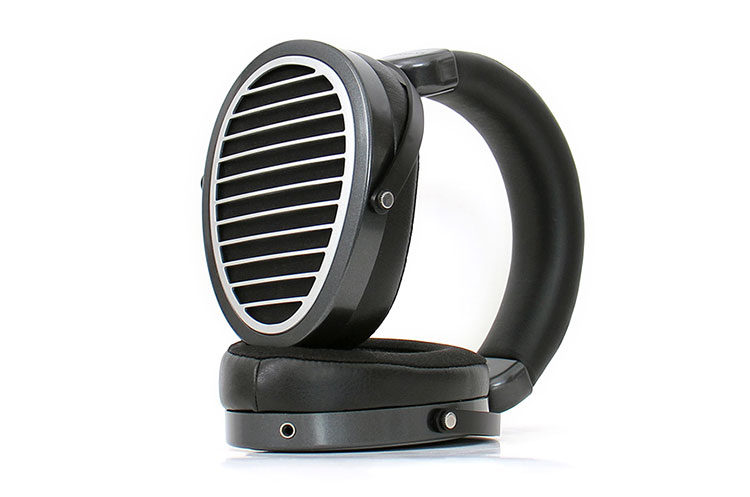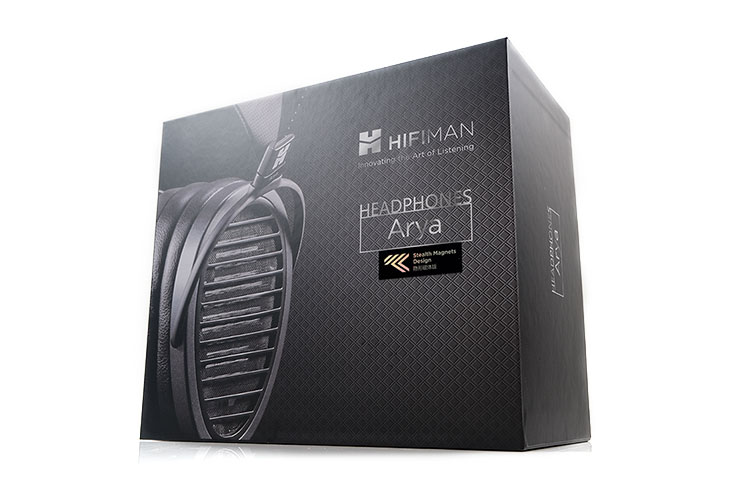Synergy
Efficiency
The Arya Stealth is rated at 32Ω and 94dB SPL so not the most efficient headphone in HIFIMAN’s range with the Ananda still the top dog for me in terms of easy-to-drive performances.
However, in our testing, it is more efficient and easier to drive than the cheaper Edition XS which is rated at 92dB SPL and 18Ω and the likes of the older flagship HE1000 (V2) also needs a bit more juice with its 35Ω and 92dB SPL benchmark.
You can get away with a DAP, most modern DAPs in balanced output mode can deliver 500mW and upwards which will give you a pleasant if somewhat polite tonality. If anything, the bass performance is where you will notice the difference once you up the voltage and current capability of any amplifier you connect to the Arya Stealth.
For example, the HiBy RS6 sounds very smooth and euphonic, a lovely pairing in terms of coloration but switch to the FiiO M17’s 1.5W 4.4mm output and the staging magnifies, the bass tightens up and the delivery has a much more holographic and detailed driver performance. You can tell the Arya driver loves the additional power.
The same again once you go to a large desktop setting such as the Feliks Audio Envy‘s high impedance setting which releases up to 16V. The Arya Stealth scales up beautifully sounding very dynamic and inciteful compared to the softer DAP performances such as the RS6.
Pairings
Tonal pairing is a different ball game with the Arya and will come down to how you like your bass and treble delivered. My own personal preference was for a warmish-sounding solid-state sound or a tube amplifier with a solid-state rectifier. Vacuum rectifiers sounded very sweet but perhaps a bit too relaxed and you want that Arya Stealth bass as tight and responsive as possible.
Two good examples are the Ferrum ORR and LP P6 Pro combo (line out) and the M17 or the FiiO K9 Pro ESS setup (either, or linked via the M17 digital out).
The former delivered the most life-like timbre, the smoothest vocal performances, and kept the treble in check from casting any sharp overtones on the upper mids timbre. However, the bass was more neutral and linear sounding. I would say beautifully refined but if you are buying the Arya Stealth for the improved bass performance there are setups that will deliver more.
The latter, or the M17 or K9 Pro ESS setup delivered the punchiest low-end with a snappier mid-bass response but in turn, the timbre was much cooler compared to the OOR/P6 Pro pairing. These two are less forgiving for bright recordings with the Arya Stealth.
I have to admit I was caught between the two depending on my mood and preference. The FiiO sources and amps tended to amplify a little edginess on the Arya Stealth treble so you have to pick your genres carefully. Anything too splashy or with a lot of high synth notes, I would switch to the smoother R2R source setup.
A brilliant combination of both of those characteristics is the Feliks Audio Envy but this might be overkill unless you happen to already have it. Its high voltage release and excellent current headroom combined with a solid-state rectifier deliver an improved bass response in terms of dynamic impact but also injected a bit more warmth throughout the Arya Stealth’s FR.
Select Comparisons
All comparisons were tested with a mix of components including Holo Audio’s Spring DAC 2, Feliks Audio Envy, dCS Bartok, and FiiO’s K9 Pro ESS.
HIFIMAN Ananda
$999 (currently $699 Special price)
The Ananda was launched in mid-2018 and is arguably one of HIFIMAN’s most popular headphones with a good price to performance ratio. Even more so with the street price today much lower than its original SRP.
Technical
Both the Ananda and the Arya Stealth share a lot of the recent HIFIMAN technology. That includes an NsD diaphragm, a dual-sided magnet array, and the window shade grill design.
However, time does not stand still, and I do believe the current NsD inside the Arya is even thinner in terms of microns compared to the original Ananda version. The magnet array is also the other big change with the Arya using the newer stealth magnet array compared to the Ananda’s older asymmetrical large and small magnet implementation.
The main thrust of the former over the latter also included the efficiency level. The Ananda is rated at 25Ω and 103dB SPL compared to the Arya Stealth at 32Ω and 94dB and it is still the easier of the two to drive.
That usually meant portable devices were a ‘go’ for Ananda owners whereas the Arya Stealth feels more at home with a proper desktop amplifier. The Arya Stealth is by no means a difficult headphone to drive but it does perform better with more current and voltage headroom compared to the Ananda.
Design
From afar both look very similar save for the dark paint job on the Arya Stealth. However, close up there are quite a lot of important design differences. The first is the articulation, which the Arya has a lot more both vertically and horizontally.
The Ananda was part of that wave of HIFIMAN headphones that cut down on the number of articulating parts, I presume to reduce the number of potential failures. That means the Ananda has quite a stiff frame with only the cup articulating through its vertical axis. It is still a quite comfortable fit but not quite as flexible for varying head shapes.
The second difference is the pressure strap. I prefer the surface finish of the Ananda strap which has more of a leathery look but can’t deny that it is flimsier than the Arya Stealth’s newer padded version. It is marginally more comfortable also.
More nuanced touches include the gimbal arches which are more refined with no exposed screws on the Arya Stealth and a piano black glossy finish compared to the duller finish of the Ananda cups.
The pads on this Ananda here are the older hybrid types with the stitching positioned a bit further in and touching your ears. The Arya Stealth pads have them more on the edges which are comfier. I suspect this is a running change and recent Ananda’s will have the newer pads.
The cables on both have the same single-crystalline wiring but the Ananda uses the older rubbery tubing albeit a solid grey compared to the transparent version in the picture above. I believe the Ananda also still comes in that excellent leather display box with an additional SE 6.35m 3m cable which makes me wonder why the Arya Stealth couldn’t get the same quality packaging.
Performance
The Arya clearly uses a superior driver to the Ananda. Terms like improved dynamic range, more treble presence, and better imaging leap out right away. The Arya Stealth is simply the more energetic and vivid sounding headphone.
The Ananda is not without its charm, however. It has a smoother tone with slightly less upper treble energy. You lose a little in headroom but the timbre for some might be more relaxing.
The major issue though for me with the Ananda is those mids. This is really a preference thing for me personally but I always found the mids a little relaxed or disconnected. The Arya Stealth has a more pronounced 2-4k region and whilst it doesn’t shove the vocals down your throat they do sound more immediate and expressive.
The bass response has a similar theme and again I must emphasize these are not bass cannons but comparatively speaking, the Arya Stealth has the stronger low-end.
Not just in quantity and absolute depth sub-100Hz, but also in terms of a faster transient response and that improved dynamic range and definition. The low-end clarity on the Arya Stealth is a step up, as a result, and the space and layering are much more noticeable.
Neither has huge staging width but the Arya has better depth, imaging, and a more holographic soundstage. If anything, the Arya Stealth pulls you into the music a little more with its stronger 2-4k rise but perceived clarity wins over the laid-back Ananda performance.
The timbre is cleaner on the Arya Stealth and more accurate to my ear for both vocals and instruments. At the very top end, it can get a little harder-edged and that is where the smoother Ananda sound holds its appeal despite the slightly diminished imaging and resolving capability.
HIFIMAN Edition XS
$499
The Edition XS was reviewed by Louis just a few weeks ago but luckily I acquired a unit and despite its price disparity, it does share some common traits with the Arya Stealth.
Technical
The main shared characteristics between these two headphones are the NsD diaphragm technology and the new stealth magnet implementation. Both also use the window shade grill design so in that respect, at least at a high level these two are offering similar features.
The coils though are different and ironically, the Edition XS is less efficient. If you remember the original Edition X was lauded as being very easy to drive compared to the other HIFIMAN headphones at the time. That mantle is now more with the Ananda.
The Edition XS rated at 92dB SPL and 18Ω compared to the slightly easier 94dB SPL from the Arya Stealth and a 32Ω resistance level. Both are very close but in our testing, the Arya Stealth just shaded it for me for efficiency and dynamic range on our test amps, the Ferrum OOR and the FiiO K9 Pro ESS.
Design
Like the Ananda, these two headphones share that familiar teardrop cup form factor but I guess to meet the price point, the XS has a lot of the cheaper styling from the Deva including that taller single band heavily cushioned headband, and plastic pivot blocks.
The XS is not as flexible as the Arya Stealth for articulation and stretch but it does have a little more lateral swivel compared to the Ananda. Both use the latest hybrid earpads with stitching on the edges which are comfier for longer listening sessions.
In truth, the comfort levels are excellent on both but the narrower contact surface of the cheaper single headband of the XS makes it sit a little higher up and not as steady when the head moves. The XS cups sit a little higher on the sides of your head also due to the taller headband, however, which might suit some with smaller heads.
Aesthetics-wise the XS has the older two-tone silver and black of the previous Ananda and Edition X models. The Arya Stealth stands out with that more menacing all-black look which I like a lot. The finishing in general on the Arya Stealth just looks more premium to me with a better quality headband system, no exposed screws, or cheaper plastics for the pivots.
Both use the exact same 1.5m single crystalline copper wire with a nylon jacket with the included 6.35mm SE adaptor attached to the 3.5mm SE termination. Same splitter, same 3.5mm connectors. Given the price difference, I do think the Arya deserves more attention here with at least one balanced XLR 3m alternative in the box.
Performance
Both of these headphones are tuned in a similar manner save for the treble curve which sounds feistier on the Arya Stealth but in a good way. However, the quality of the Arya Stealth driver is a big step up on the Edition XS version and that does bring immediate technical differences, especially on the low-end.
Both headphones have an elevated low-end delivery, though by no means bass-heavy. Louis’s assessment is quite correct in how the Edition XS ups the bass level over the older models. However, the Edition XS bass is more about mid-bass punch with a flatter 50Hz point so the sub-bass is in line or maybe 1-2dB behind and not as distinct.
The Arya Stealth peak bass seems a little lower down and more on that 50-60Hz region and sounds the beefier of the two for sub-bass presence. More than that, it is tighter with a faster transient response so the articulation is more noticeable than the Edition XS bass performance. Audio tracks show off a more distinct and improved dynamic range on the low-end as a result.
Notes also sound a lot more defined with better texture on the low-end whereas the Edition XS sounds a little less distinct and slightly flabbier in comparison.
The Arya Stealth also pulls in more 6-8k energy which produces cleaner timbral coloration. That will help with the perception of detail and picking up on those nuanced imaging cues in terms of instrumental placement.
The Edition XS, as a result, feels a bit more diffuse in its imaging, especially through the mids which have a slightly hollow character compared to the physical and more upfront Arya Stealth. I suspect also that Arya Stealth’s 2-4k range is more pronounced with vocals coming in with a lot more clarity and authority.
HIFIMAN HE1000 V2
$2999 (Open Box $2199)
The HE1000 V2 was the last flagship-level teardrop-shaped HIFIMAN headphone I reviewed back in 2016. The SE version, which builds on the V2, somehow slipped my attention.
Technical
Despite its higher price tag, the V2 is pretty much a snapshot of the previous generation of HIFIMAN driver technology wrapped around one of their best planar magnetic voice coils.
That means a nanotechnology-inspired super-thin diaphragm but not quite NsD levels of thin by today’s HIFIMAN driver standards. We are talking micron levels of differences and both are sub-micron, to begin with, but they all count.
The other key difference between these two is the magnet array design. Both are dual-sided magnet array implementations but the HE1000 V2 uses the older asymmetrical magnet array design with the large magnets on the outside and the smaller on the inside rather than the newer stealth magnet system inside the Arya Stealth.
Both headphones use the Window Shade Grill system which, to be honest, every teardrop-style HIFIMAN headphones use, both cheap and flagship-level. Keeps them really open in terms of acoustical space whilst protecting the driver at the same time.
The V2 is rated at 35Ω and 92dB with a bit more trace resistance in the voice coil compared to the 32Ω and 94dB rating of the Arya Stealth driver. I would still rate the HE1000 V2 voice coil to be the higher quality driver compared to the Arya Stealth version but it is less efficient and you do need more power to drive the HE1000 V2 as a result.
Design
It is the classic look versus the new look but the form factor is almost identical between the HE1000 V2 and the Arya Stealth. There is also only a 16g weight difference between these two so in the hand or on the head you will not feel much of a difference.
The aesthetics and materials choices do differ with the HE1000 V2 using some judiciously placed premium materials, better packaging, and a more complete set of cables (balanced and SE). The wood veneer and CNC milled silver contrast of the V2 also has a more ‘gentlemanly’ feel to the muscular black finish of the Arya.
The premium is mainly in the headband pressure strap with a choice of a higher quality suede material and plenty of circular venting. The Arya Stealth uses a cheaper synthetic finish but granted, it has slightly better-ribbed padding underneath whereas the V2 has no padded undercarriage.
It might be my imagination but the metal headband and pivot blocks on the V2 feels a little sturdier and with a slightly better finish than the Arya Stealth version. It is hard to tell as the V2 has that nice aged silvery finish compared to the monotone black of the Arya.
Both headbands and pivot blocks operate in the exact same manner with both headphones offering the same excellent vertical and lateral articulating capability and similar comfort levels.
You will notice, however, the gimbals on the V2 are a little further away from the cups compared to the Arya’s lower profile gimbal structure. That seems to be a running product improvement from HIFIMAN with the screws further inset into the cup and does look tidier.
Performance
Old HIFIMAN meets new HIFIMAN with both timbral and technical differences between the Arya Stealth and the HE1000 V2. Probably the most noticeable tonal shift is the low-end of the Arya which moves a bit more air for me and sounds the heavier and more planted of the two low-ends.
The HE1000 V2 is more neutral on the low-end, a little cleaner, and less boomy also. The depth is excellent and the control is even tighter on the V2 bass performance but everyone will have a preference here. More bass weight or a cleaner more refined bass delivery, both will tick boxes.
However, what the V2 does spatially is to pull your ear up a bit more into the mids and treble, and here you can perceive an improved technical performance with male vocals offering a bit more clarity and space whereas the Arya is just slightly less resolving or vivid sounding for vocal clarity.
Some of that elevation from the Arya Stealth bass is a few dB above the natural vocal range of 1-2k so it can dominate a bit more and push them back whereas the HE1K V2 has a rising lower-mids almost from 600-800Hz to about 3k.
That rise plus a stronger 5-7k peak does mean the HE1K V2 is the more vivid and cleaner of the two for timbre but its control of sibilance and splashiness is very good. The Arya is slightly smoother sounding through the same area but not quite as resolving or offers as much airy headroom as the H1K V2 staging capability.
Our Verdict
The Arya Stealth provides an excellent introduction to HIFIMAN’s flagship house sound and one that is considerably beefier than what I am used to with the introduction of the new Stealth Magnet technology.
It presents a very strong halfway house between tonally similar but far less resolving models such as the Edition XS and for those who want something punchier than what the Ananda provides.
It’s not all about the bass either, the Arya Stealth’s dynamic range delivers a very involving performance, particularly with amps known for their punchy tuning signature.
This is not the biggest staging performance but the level of resolution, cleaner coloration, and impressive imaging provide enough room for everything to come across with impressive clarity.
The Arya Stealth should be a popular choice with a price point that is reasonable in my estimation in terms of what you get in return. Just upgrade that cable and pair it with a smooth-sounding amp and it is good to go.
HIFIMAN Arya Stealth Version Specifications
- Impedance: 32Ω
- Sensitivity: 94dB
- Frequency response: 8Hz – 65kHz
- Weight: 404g (14.3oz)







